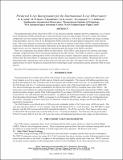| dc.contributor.author | Bautz, Marshall W. | |
| dc.contributor.author | Smith, R. K. | |
| dc.contributor.author | Bookbinder, J. | |
| dc.contributor.author | Garcia, M. R. | |
| dc.contributor.author | Guainazzi, M. | |
| dc.contributor.author | Kilbourne, C. A. | |
| dc.date.accessioned | 2011-03-10T19:11:54Z | |
| dc.date.available | 2011-03-10T19:11:54Z | |
| dc.date.issued | 2010-06 | |
| dc.identifier.issn | 0277-786X | |
| dc.identifier.uri | http://hdl.handle.net/1721.1/61647 | |
| dc.description.abstract | The background that will be observed by IXO's X-ray detectors naturally separates into two components: (1) a Cosmic X-ray Background (CXB), primarily due to unresolved point sources at high energies (E>2 keV), along with Galactic component(s) at lower energies that are generated in the disk and halo as well as the Local Bubble and charge exchange in the heliosphere, and (2) a Non-X-ray Background (NXB) created by unvetoed particle interactions in the detector itself. These may originate as relativistic particles from the Sun or Galactic Cosmic Rays (GCR), creating background events due to both primary and secondary interactions in the spacecraft itself. Stray light and optical transmission from bright sources may also impact the background, depending upon the design of the baffles and filters. These two components have distinct effects on observations. The CXB is a sum of power-law, thermal, and charge exchange components that will be focused and vignetted by the IXO mirrors. The NXB, in contrast, is due to particle, not photon, interactions (although there will be some fluorescence features induced by particle interactions), and so will not show the same effects of vignetting or trace the effective area response of the satellite. We present the overall background rates expected from each of these processes and show how they will impact observations. We also list the expected rates for each CXB process using both mirror technologies under consideration and the predicted NXB for each detector. | en_US |
| dc.language.iso | en_US | |
| dc.publisher | Society of Photo-optical Instrumentation Engineers | en_US |
| dc.relation.isversionof | http://dx.doi.org/10.1117/12.857529 | en_US |
| dc.rights | Article is made available in accordance with the publisher's policy and may be subject to US copyright law. Please refer to the publisher's site for terms of use. | en_US |
| dc.source | SPIE | en_US |
| dc.title | Predicted X-ray backgrounds for the International X-ray Observatory | en_US |
| dc.type | Article | en_US |
| dc.identifier.citation | Smith, R. K. et al. “Predicted x-ray backgrounds for the International X-ray Observatory.” Space Telescopes and Instrumentation 2010: Ultraviolet to Gamma Ray. Ed. Monique Arnaud, Stephen S. Murray, & Tadayuki Takahashi. San Diego, California, USA: SPIE, 2010. 773246-8.© 2010 SPIE. | en_US |
| dc.contributor.department | MIT Kavli Institute for Astrophysics and Space Research | en_US |
| dc.contributor.approver | Bautz, Marshall W. | |
| dc.contributor.mitauthor | Bautz, Marshall W. | |
| dc.relation.journal | Proceedings of SPIE--the International Society for Optical Engineering ; v. 7732 | en_US |
| dc.eprint.version | Final published version | en_US |
| dc.type.uri | http://purl.org/eprint/type/ConferencePaper | en_US |
| dspace.orderedauthors | Smith, R. K.; Bautz, M. W.; Bookbinder, J.; Garcia, M. R.; Guainazzi, M.; Kilbourne, C. A. | en |
| dc.identifier.orcid | https://orcid.org/0000-0002-1379-4482 | |
| mit.license | PUBLISHER_POLICY | en_US |
| mit.metadata.status | Complete | |
